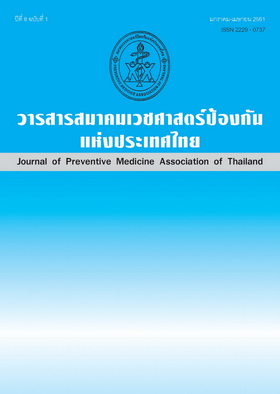Utility Weight and Quality of Life in Thai Diabetes Mellitus Patients Measured by EQ-5D and Thai DQOL
Abstract
In Thailand, the prevalence rate of diabetes mellitus (DM) was 6.9 per 100. Diabetes Mellitus could produce many complications and increase mortality rate. In order to do a health technology assessment for diabetes mellitus, we need a utility weight (UW) to compute quality-adjusted life year. Therefore, this study aimed to (1) measure UW from Euroqol-5D (EQ-5D), (2) analyze factors associated with UW and (3) analyze relation
between UW and Thai-Diabetes Quality of Life (DQOL) in multiple conditions such as no complication, nephropathy, neuropathy, retinopathy, glaucoma, cataract, and amputation. We performed cross sectional study; 558 samples were enrolled from out-patients and in-patients in 5 regional hospitals throughout Thailand since 2009-2010. Data analysis was done with Pearson’s correlation and ANOVA.
The largest group of samples was collected from Saraburi province (26.2%), average age was 57 (S.D. 12) years old, 40.5% were male, 50.9% were living in suburban area and 73.8% used universal coverage scheme. The UW ranged from 0.42 (S.D. 0.26) to 0.85 (S.D. 0.19). The lowest UW was found in diabetes mellitus with amputation, while the highest one was found in diabetes mellitus without complication. Quality of life could
differ from various complications (p<0.05), fasting blood sugar (p<0.001), occupation (p=0.002) and area of living (p=0.03). Moreover, we found significant relation between UW from EQ-5D and the Thai DQOL score (Pearson r=0.519). The key strength of this finding was delivering function to estimate UW by the Thai-DQOL score.
The current investigation was limited by lack of amputation details and course of diseases. Thus, further research might explore more detail in severity of the amputation.
References
2. วิชัย เอกพลากร, เยาวรัตน์ ปรปักษ์ขาม, สุรศักดิ์ ฐานีพานิชสกุลม, และคณะ. รายงานการสำรวจสุขภาพประชาชนไทยโดยการตรวจร่างกายครั้งที่ 4 พ.ศ. 2551-2552. (เข้าถึงเมื่อวันที่ 21 เมษายน 2561). เข้าถึงได้จาก : https://kb.hsri.or.th/dspace/handle/11228/2976?locale-attribute=th
3. กระทรวงสาธารณสุข. อัตราการป่วยตายด้วยโรคเบาหวาน [อินเตอร์เน็ต] นนทบุรี; 2561 (เข้าถึงเมื่อวันที่ 18 พฤษภาคม 2561). เข้าถึงได้จาก https://hdcservice.moph.go.th/hdc/reports/report.php?source=formated/ncd_death_age.php&ca t_id=6a1fdf282fd28180eed7d1cfe0155e11&id=589248f2516fbb85d4a4a5605c3ca1c4#
4. สำนักนโยบายและยุทธศาสตร์ กระทรวงสาธารณสุข. รายงานสถิติสาธารณสุข พ.ศ. 2558 นนทบุรี: โรงพิมพ์องค์การสงเคราะห์ทหารผ่านศึก; 2559.
5. สำนักโรคไม่ติดต่อ กรมควบคุมโรค กระทรวงสาธารณสุข. รายงานประจำปี 2558. นนทบุรีฯ: โรงพิมพ์องค์การสงเคราะห์ทหารผ่านศึก; 2559.
6. Flegg JA, McElwain DL, Byrne HM, Turner IW. A three species model to simulate application of Hyperbaric Oxygen Therapy to chronic wounds. PLoS Comput Biol 2009;5(7):e1000451.
7. Centers for Disease Control and Prevention. National Diabetes Fact Sheet: General Information and National Estimates on Diabetes. US: Atlanta; 2009.
8. Robbins JM, Strauss G, Aron D, Long J, Kuba J, Kaplan Y. Mortality rates and diabetic foot ulcers: is it time to communicate mortality risk to patients with diabetic foot ulceration? J Am Podiatr Med Assoc. 2008;98(6):489-93.
9. Liu R, Li L, Yang M, Boden G, Yang G. Systematic review of the effectiveness of hyperbaric oxygenation therapy in the management of chronic diabetic foot ulcers. Mayo Clin Proc. 2013;88(2):166-75.
10. สุภามาศ ผาติประจักษ์, สมจิต หนุเจริญกุล, เปียซื่อ น. ปัจจัยทำนายความสามารถในการดูแลตนเองและคุณภาพชีวิตในผู้เป็นเบาหวานชนิดที่ 2. Rama Nurs J. 2014;20(1):97-110.
11. Tongsiri S, Cairns J. Estimating population-based values for EQ-5D health states in Thailand. Value Health 2011;14(8):1142-5.
12. Grandy S , Fox KM. EQ-5D visual analog scale and utility index values in individuals with diabetes and at risk for diabetes: Findings from the Study to Help Improve Early evaluation and management of risk factors Leading to Diabetes (SHIELD). Health and Quality of Life Outcomes 2008 Feb;27(6):18).
13. Redekop WK, Koopmanschap MA, Stolk RP, Rutten GE, Wolffenbuttel BH, Niessen LW. Health-Related Quality of Life and Treatment Satisfaction in Dutch Patients With Type 2 Diabetes. Diabetes Care 2002;25:458-63.
14. James E Graham DGS-M, Glenn V Ostir, Soham Al, Snih MKP, Kyriakos Markides, Kenneth J. Ottenbacher Health related quality of life in older Mexican Americans with diabetes: A cross-sectional study. Health and Quality of Life Outcomes. 2007;5(39).
15. Ministry of Public Health T. Burden of Disease Report, Thailand. 2004.
16. สำนักงานหลักประกันสุขภาพแห่งชาติ สสส. แนวทางเวชปฏิบัติสำหรับโรคเบาหวาน พ.ศ. 2551. บริษัท รุ่งศิลป์การพิมพ์ (1977) จำกัด; 2008.
17. Sarah Wild GRea. Global burden of diabetes mellitus in the year 2000. (เข้าถึงเมื่อวันที่ 18 พฤษภาคม 2561). เข้าถึงได้จาก Available from: https://www.who.int/healthinfo/statistics/bod_diabetes.pdf.
18. Kent M, Wang T, Whyte R, Curran T, Flores R, Gangadharan S. Open, video-assisted thoracic surgery, and robotic lobectomy: review of a national database. Ann Thorac Surg. 2014;97(1):236-42; discussion 42-4.
19. Beaudet A, Clegg J, Thuresson PO, Lloyd A, McEwan P. Review of utility values for economic modeling in type 2 diabetes. Value Health. 2014;17(4):462-70.
20. Bagust A, Beale S. Modelling EuroQol health-related utility values for diabetic complications from CODE-2 data. Health Econ. 2005;14(3):217-30.
21. Paul Glasziou JA, Elaine Beller, Philip Clarke and the ADVANCE Collaborative Group. Which health-related quality of life score? A comparison of alternative utility measures in patients with Type 2 diabetes in the ADVANCE trial. Health and Quality of Life Outcomes 2007;5(21).
Downloads
Published
How to Cite
Issue
Section
License
บทความที่ลงพิมพ์ในวารสารเวชศาสตร์ป้องกันแห่งประเทศไทย ถือเป็นผลงานวิชาการ งานวิจัย วิเคราะห์ วิจารณ์ เป็นความเห็นส่วนตัวของผู้นิพนธ์ กองบรรณาธิการไม่จำเป็นต้องเห็นด้วยเสมอไปและผู้นิพนธ์จะต้องรับผิดชอบต่อบทความของตนเอง






